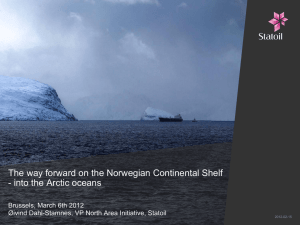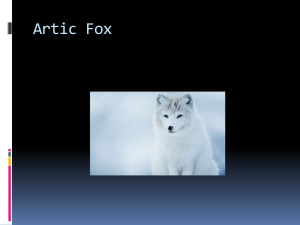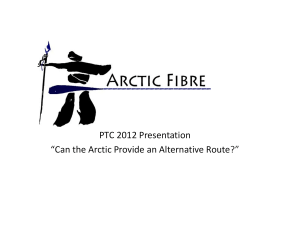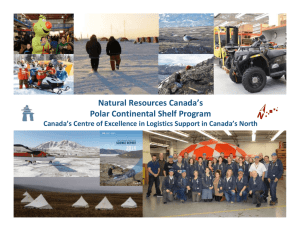Marty Bergmann`s presentation - Forum of Arctic Research Operators
advertisement
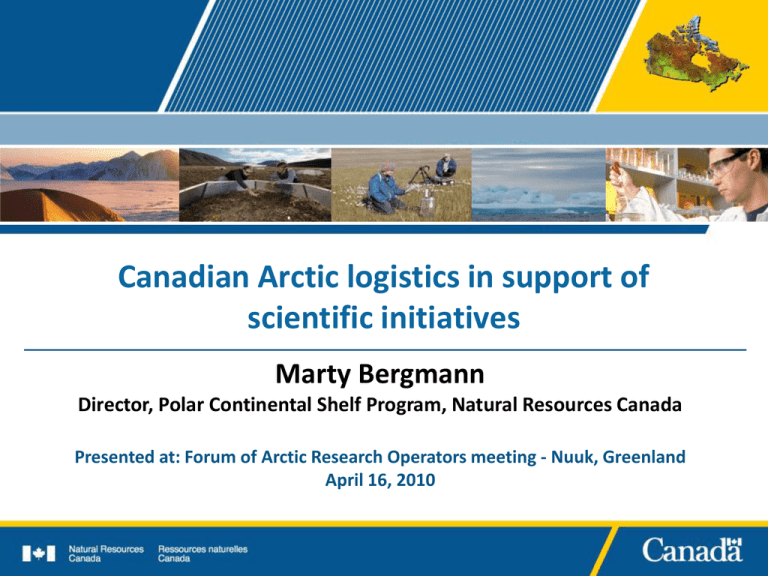
Canadian Arctic logistics in support of scientific initiatives Marty Bergmann Director, Polar Continental Shelf Program, Natural Resources Canada Presented at: Forum of Arctic Research Operators meeting - Nuuk, Greenland April 16, 2010 Canada’s North: Challenges for field research The vast expanse of the Canadian Arctic (>4,000,000 km2), varied terrain and extreme climate conditions make logistical operations difficult Most field camps in the Canadian Arctic are located in remote areas that are accessible only by certain aircraft (e.g., Twin Otter and helicopter) or ice-capable ships Field studies are costly but new government initiatives are improving northern research infrastructure and various northern logistics organizations can provide scientists with cost-effective field support 2 Canada Canadian High Arctic Research Station (CHARS) In 2007, the Government of Canada announced plans to build a world-class science facility in the Canadian High Arctic A feasibility study has been completed by Indian and Northern Affairs Canada (INAC) The location of the CHARS has been narrowed to three Nunavut communities: Resolute, Cambridge Bay or Pond Inlet In Budget 2009, the Government of Canada announced $87M for the Arctic Research Infrastructure Fund In Budget 2010, the Government of Canada announced $18M for the design of the CHARS Details regarding logistical support for work at the CHARS have yet to be determined 3 Arctic Research Infrastructure Fund (ARIF) Excerpt from the Government of Canada’s Budget 2009: “…new funding of up to 85 million for INAC to invest in upgrading key existing Arctic research facilities… providing a near-term economic stimulus while building a strong foundation for Arctic research capacity that supports government priorities… ensure a robust network of infrastructure is in place when the Canadian High Arctic Research Station opens”. Information courtesy of INAC 4 Arctic Research Infrastructure Fund Projects Churchill Northern Studies Centre Photo credit: M. Goodyear 20 projects at 37 sites were selected for funding Much needed investment to replace/renovate many facilities that represent a legacy to the last International Polar Year Proponents had to mobilize quickly to deliver on two-year timeline Nunavut Research Institute (NU) Photo credit: E. Corneau PCSP Resolute - design concept Information and photos courtesy of INAC 5 Arctic Research Infrastructure Fund – Project Sites 4 7 1 17 8 2 15 2 7 16 2 4 3 2 9 19 20 6 2 11 7 14 13 2 7 2 8 2 1 10 12 10 5 2 Arctic Research Infrastructure Fund Projects (numbers cross-referenced with list on next slide) Note: Map is for illustrative purposes only. 4 4 4 4 4 Map courtesy of INAC 6 Arctic Research Infrastructure Fund Recipients 1. Institute for Circumpolar Heath Research, Northwest Territories Project Lead: Arctic Health Research Network, Northwest Territories 2. Arctic Migratory Bird Research Network Project Lead: Environment Canada 3. Aurora Research Institute Project Lead: Aurora College 4. Centre d'études nordiques (CEN) - SAON Network Project Lead: Université Laval 5. Churchill Northern Studies Centre Project Lead: Churchill Northern Studies Centre 6. H. S. Bostock Geological Core Library Project Lead: Yukon Geological Survey 7. Health Canada Radiological Monitoring Network Project Lead: Health Canada 8. kANGIDLUASUk Base Camp Project Lead: Nunatsiavut Government 14. Nunavut Research Vessel Project Lead: Government of Nunavut 9. Kluane Lake Research Station Project Lead: Arctic Institute of North America 15. Old Crow Research Facility Project Lead: Vuntut Gwitchin Government 10. Labrador Institute & Nunatsiavut Research Centre Project Lead: Government of Newfoundland and Labrador & Nunatsiavut Government 16. Polar Continental Shelf Program Project Lead: Natural Resources Canada 11. M'Clintock Channel Polar Bear Research Cabins Project Lead: Queen’s University 18. Quttinirpaaq National Park Project Lead: Parks Canada 12. Nunavik Research Centre Project Lead: Makivik Corporation 17. Polar Environment Atmospheric Laboratory Project Lead: Dalhousie University 19. Yukon College Project Lead: Yukon College 20. Yukon Forestry Project Lead: Government of Yukon 13. Nunavut Research Institute Project Lead: Nunavut Arctic College Information courtesy of INAC 7 Polar Continental Shelf Program (PCSP) Detailed information on PCSP was provided at last year’s FARO meeting • Most operations are based out of PCSP’s Resolute, Nunavut, facility, but aircraft services are also available from other key northern locations Scientists can apply to PCSP annually for a range of services, including: Air transportation (e.g., Twin Otters, helicopters) Transit residence and meals at Resolute Field equipment from PCSP’s Technical Field Support Services Fuel for aircraft, equipment and camps Communications network for all field camps Twin Otter at Beechy Island, Nunavut 8 PCSP’s clients Researchers from the Canadian federal, territorial and provincial governments, universities, private organizations and international agencies can apply for PCSP logistical services each year in November PCSP supports up to 200 research projects annually that include over 1100 scientists, students and field support personnel in disciplines ranging from archaeology to zoology 9 PCSP-supported field camps (2009) 10 PCSP Resolute Facility Expansion PCSP received $11M from ARIF to expand the PCSP Resolute facility This expansion will nearly double the capacity of the facility and provide more effective work space for researchers and staff 11 PCSP’s work with the Department of National Defence The Department of National Defence (DND) has a presence in Resolute for training operations and a planned Arctic Training Centre With this presence, telecommunications abilities for PCSP will continue to increase PCSP is working with DND regarding operations in Resolute and how best to meet common goals The CF Canadian Air Division is now responsible for the Alert and Eureka military outposts on Ellesmere Island, Nunavut 12 Canadian Arctic marine science logistics Canadian Coast Guard (CCG) icebreakers are the backbone to vesselbased research in the Canadian Arctic CCG works with the National Centre for Arctic Aquatic Research Excellence (NCAARE, Fisheries and Oceans Canada) for overall planning of the ships Currently, eight of CCG’s fleet of 18 icebreakers operate in Canada’s North and have provided support for science programs The duration of science programs varies by ship and by year Programs last a few days to a few months each year, and sometimes overwintering projects are conducted Icebreakers typically begin their Arctic cruises in mid-June to mid-July and return to their southern ports by October to mid-November, depending on programming needs and ship capabilities Information courtesy of NCAARE, DFO 13 Science programs on CCG ships Ship-based scientific activities range from marine biology and oceanography to seabed geology Main types of scientific activities on CCG icebreakers: Mooring and ice buoy recovery/deployment Underway water collection CTD/Rosette • Current major programs: Joint Ocean Ice Study Canada’s United Nations Convention on the Law of the Sea (UNCLOS) Program Arctic Mooring Program ArcticNet on CCGS Amundsen Current sampling programs : Canada’s Three Oceans Barrow Strait Ecosystem Study Information courtesy of NCAARE, DFO 14 ArcticNet is a Canadian Network of Centres of Excellence that brings together researchers in the natural, human health and social sciences with Inuit organizations, northern communities, and federal, provincial and private sector agencies to study the impacts of climate change in the coastal Canadian Arctic Within ArcticNet, over 110 researchers from 27 Canadian universities, and 8 federal and 11 provincial organizations collaborate with scientists from 12 countries Marine science and some community-based work is conducted aboard the CCGS Amundsen The CCGS Amundsen: a Canadian research icebreaker for international collaboration in the study of the changing Arctic Information courtesy of ArcticNet 15 8 Ton Deck cranes Lab containers 733 Zodiac MVP300 60hp Winch AFT labs CTD-Rosette deployment area, A-frame, 40 hp winch Information courtesy of ArcticNet 10 ton A-frame & 500hp winch Barge Helodeck Halftrack Moonpool, acoustic well & EM300 sounder Paleo/benthos labs 16 ArcticNet and CCGS Amundsen – Cruise Tracks 2003-2008 Providing major access to the Arctic for the Canadian and international scientific community since its inauguration in 2003 2003 - 2008 Cruise Tracks Information courtesy of ArcticNet 17 ArcticNet and CCGS Amundsen – Cruise Tracks 2009-2010 Providing major access to the Arctic for the Canadian and international scientific community since its inauguration in 2003 2009 & 2010 Cruise Tracks (Planned) Information courtesy of ArcticNet 18 CCGS Amundsen – Support for recent Arctic research programs 1300 days of dedicated scientific operations over 8 years or 163 days per year on average Supported 2 major international overwintering studies in the Beaufort Sea (CASES & CFL) Supported science teams from 15 countries Visited all Canadian coastal Inuit communities as part of an international Inuit Health Survey 448 days overwintering expedition 390 days overwintering expedition Days of dedicated science operations 2003 2004 2005 2006 2007 Year 19 2008 2009 2010 Information courtesy of ArcticNet Logistical support for Canadian Arctic research Ongoing initiatives by the federal government are actively improving northern infrastructure in support of Canadian Arctic science International programs and MOUs (e.g., Canada and the United Kingdom, PCSP and northern Canadian colleges) play important roles in the further evolution of Canadian Arctic science There is more work to be done, as there is a significant gap between the logistical support requested by scientists and what can be afforded by logistical operators 20




